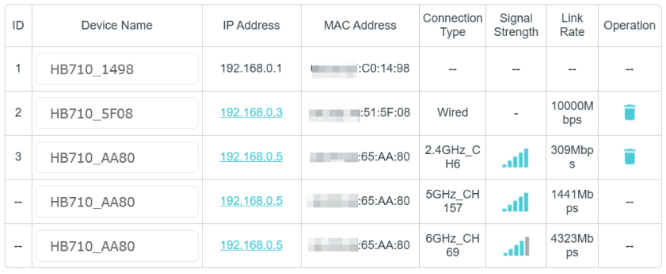Troubleshooting intermittent or no Wi-Fi connection
1. Monitor Link Rate and Signal Strength:
- Check the link rate and RSSI/Signal Strength of your device via the router/AP node in WebUI or Aginet APP.
- If the link rate is low or the RSSI/Signal Strength value is too low, this could cause an unstable connection. Try moving the device closer to the router/AP node and monitor again.
- Wi-Fi Signal Strength value rating table as below:
|
Signal Strength (dBm) |
Rating |
Description |
|
-30 to -50 |
Excellent |
Perfect or near-perfect signal strength. Online activities can be carried out seamlessly without fear of disconnection. |
|
-51 to -60 |
Good |
High signal strength. Good enough for most online activities, including high-intensity gaming and video streaming. |
|
-61 to -70 |
Fair |
Decent signal strength. Sufficient for everyday tasks like emails and Web surfing. |
|
-71 to -80 |
Poor |
Low level of connectivity. There may be occasional disconnects and data loss. |
|
-81 or lower |
Very weak |
Near-complete disconnection. Data loss and mid-task disconnections are frequent. |
2. Address Blind Spots:
- If there are blind spots due to the main router’s coverage limitations, consider adding another mesh node to extend the wireless coverage.
- Place the router/AP node in an area with fewer obstacles, avoid placing it on the floor, and place it high off the ground to minimize transmission interference.
3. Check Backhaul Link Rate:
- Verify the wireless backhaul link rate/signal strength between the router and the wireless mesh AP node. If it’s too low, adjust the node’s placement to ensure a more stable link rate/signal strength.
- Recommendation for backhaul signal strength: Web UI displays 4 bars and above, and Aginet APP displays green color signal strength.
WebUI:

Aginet APP:

4. Wired Connection Test:
- Connect the device directly to the ONT modem to check for any drop or instability in the internet connection from the backhaul.
- Also, check the LED status of the router/ONT modem.
- If issues persist, report the unstable internet backhaul to your service provider.
5. Unique SSID Names:
- Avoid using the same Wi-Fi SSID name for the separate 2.4GHz, 5GHz, 6GHz, and MLO Wi-Fi bands.
6. Check Power Saving Mode:
- If devices are in power-saving mode, disable them and monitor their performance, as this might be causing the issue.
7. Channel Congestion:
- For potential environmental with 2.4GHz Wi-Fi channel congestion, try switching to another channel with a lower channel width in WebUI or Aginet APP settings and monitor again.
- Channel congestion status can be checked via third party APP that is related with Wi-Fi performance, and it will show the status as below, for example:

8. Compatibility Issues:
- Some older devices may not be compatible with BE mode and higher security encryption standards. Adjust the Wi-Fi band settings to 802.11 b/g/n/ac/ax (without BE) and use lower security, such as WPA2-PSK only.
Finden Sie diese FAQ hilfreich?
Mit Ihrer Rückmeldung tragen Sie dazu bei, dass wir unsere Webpräsenz verbessern.
Von United States?
Erhalten Sie Produkte, Events und Leistungen speziell für Ihre Region